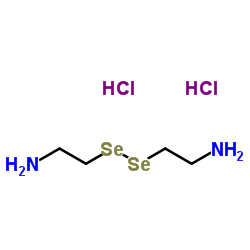An XRF study of trace elements accumulation in kidneys of tumor-bearing mice after treatment with cis-DDP with and without selenite and selenocistamine.
C Shenberg, M Boazi, J Cohen, A Klein, M Kojler, A Nyska
文献索引:Biol. Trace Elem. Res. 40(2) , 137-49, (1994)
全文:HTML全文
摘要
The effect of cis-DDP treatment with and without selenite and selenocistamine was studied on kidneys of tumor-bearing mice. The amounts of cis-DDP, selenite, and selenocistamine injected were chosen so as to be compatible with the treatment of humans. The animals were sacrificed at 7, 14, and 28 d after treatment. The kidneys were removed and subjected to trace element analysis by a novel X-ray fluorescence (XRF) method and for pathological assessment. The results show that following treatment with cis-DDP, K, Fe, Cu, and Zn reach a maximum level after 7 d; K, Fe, and Cu levels were significantly reduced by the addition of selenite. The level of Zn was reduced only in groups treated with selenite whereas that of K and Cu was reduced also in groups treated with selenocistamine with and without cis-DDP. The greatest increase in Pt and Se levels was reached 1 wk after injection with cis-DDP, with and without selenocompounds, and in the case of Pt was partly reduced by addition of selenite. Se returned to control values 2 wk after injection, although Pt was still high in all groups 2 and 4 wk after injection. The results corroborate the findings of our previous studies. The effect of selenocistamine in cis-DDP treated mice was partly insufficient. The pathological examination of the kidneys did not show any differences in the effect of various additives during the study.
相关化合物
| 结构式 | 名称/CAS号 | 分子式 | 全部文献 |
|---|---|---|---|
 |
硒代胱胺盐酸盐
CAS:3542-13-0 |
C4H14Cl2N2Se2 |
|
Pulse radiolysis studies on reactions of hydroxyl radicals w...
2008-04-10 [J. Phys. Chem. B 112(14) , 4441-6, (2008)] |
|
Oxidation of glutathione and superoxide generation by inorga...
2008-09-01 [Biofactors 31(1) , 55-66, (2007)] |
|
Separation of organoselenium compounds and their electrochem...
2004-07-01 [Anal. Bioanal. Chem 379(5-6) , 770-6, (2004)] |
|
Selenium functionalized intraocular lenses inhibit posterior...
2009-11-01 [Exp. Eye Res. 89(5) , 728-34, (2009)] |
|
Cytolysis of human erythrocytes by a covalent antibody-selen...
1995-12-01 [Free Radic. Biol. Med. 19(6) , 713-24, (1995)] |